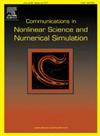弱配置网络:从聚合数据重构随机动力学的深度学习方法
IF 3.8
2区 数学
Q1 MATHEMATICS, APPLIED
Communications in Nonlinear Science and Numerical Simulation
Pub Date : 2025-09-27
DOI:10.1016/j.cnsns.2025.109360
引用次数: 0
摘要
随机微分方程(SDEs)在模拟受随机扰动显著影响的系统动力学方面起着关键作用。在这项工作中,我们提出了一种新的弱配置网络(WCN)方法来确定从聚合数据中隐藏的动态-即sde的漂移和扩散函数。该方法采用高效神经网络,特别是Kolmogorov-Arnold网络(KAN)对未知函数进行参数化。我们没有使用将数据分布与预测分布进行比较的传统度量,而是引入了从弱形式的Fokker-Planck方程推导出的有效的物理信息损失。通过利用蒙特卡罗空间积分和线性多步时间分异方法,我们的方法可以直接从观测数据中快速准确地估计Fokker-Planck方程残差。此外,通过对测试函数采样的自适应选择方法,增强了方法的鲁棒性。数值实验证明了该方法的有效性和准确性。本文章由计算机程序翻译,如有差异,请以英文原文为准。
Weak collocation networks: A deep learning approach to reconstruct stochastic dynamics from aggregate data
Stochastic differential equations (SDEs) play a key role in modeling the dynamics of systems significantly influenced by random perturbations. In this work, we propose a novel Weak Collocation Networks(WCN) method to determine the hidden dynamics-namely, the drift and diffusion functions of an SDE-from aggregate data. This method employs efficient neural networks, particularly the Kolmogorov-Arnold network (KAN), to parameterize the unknown functions. Instead of using the conventional metric that compares the data distribution with the predicted distribution, we introduce an efficient physics-informed loss derived from the weak form of the Fokker-Planck equation. By leveraging Monte Carlo spatial integration and a linear multi-step method for temporal differentiation, our approach facilitates a rapid and accurate estimation of the Fokker-Planck equation residual directly from observational data. Moreover, through an adaptive selection method for sampling the test function, we can enhance the robustness of our method. Numerical experiments demonstrate the efficiency and accuracy of our method.
求助全文
通过发布文献求助,成功后即可免费获取论文全文。
去求助
来源期刊

Communications in Nonlinear Science and Numerical Simulation
MATHEMATICS, APPLIED-MATHEMATICS, INTERDISCIPLINARY APPLICATIONS
CiteScore
6.80
自引率
7.70%
发文量
378
审稿时长
78 days
期刊介绍:
The journal publishes original research findings on experimental observation, mathematical modeling, theoretical analysis and numerical simulation, for more accurate description, better prediction or novel application, of nonlinear phenomena in science and engineering. It offers a venue for researchers to make rapid exchange of ideas and techniques in nonlinear science and complexity.
The submission of manuscripts with cross-disciplinary approaches in nonlinear science and complexity is particularly encouraged.
Topics of interest:
Nonlinear differential or delay equations, Lie group analysis and asymptotic methods, Discontinuous systems, Fractals, Fractional calculus and dynamics, Nonlinear effects in quantum mechanics, Nonlinear stochastic processes, Experimental nonlinear science, Time-series and signal analysis, Computational methods and simulations in nonlinear science and engineering, Control of dynamical systems, Synchronization, Lyapunov analysis, High-dimensional chaos and turbulence, Chaos in Hamiltonian systems, Integrable systems and solitons, Collective behavior in many-body systems, Biological physics and networks, Nonlinear mechanical systems, Complex systems and complexity.
No length limitation for contributions is set, but only concisely written manuscripts are published. Brief papers are published on the basis of Rapid Communications. Discussions of previously published papers are welcome.
 求助内容:
求助内容: 应助结果提醒方式:
应助结果提醒方式:


